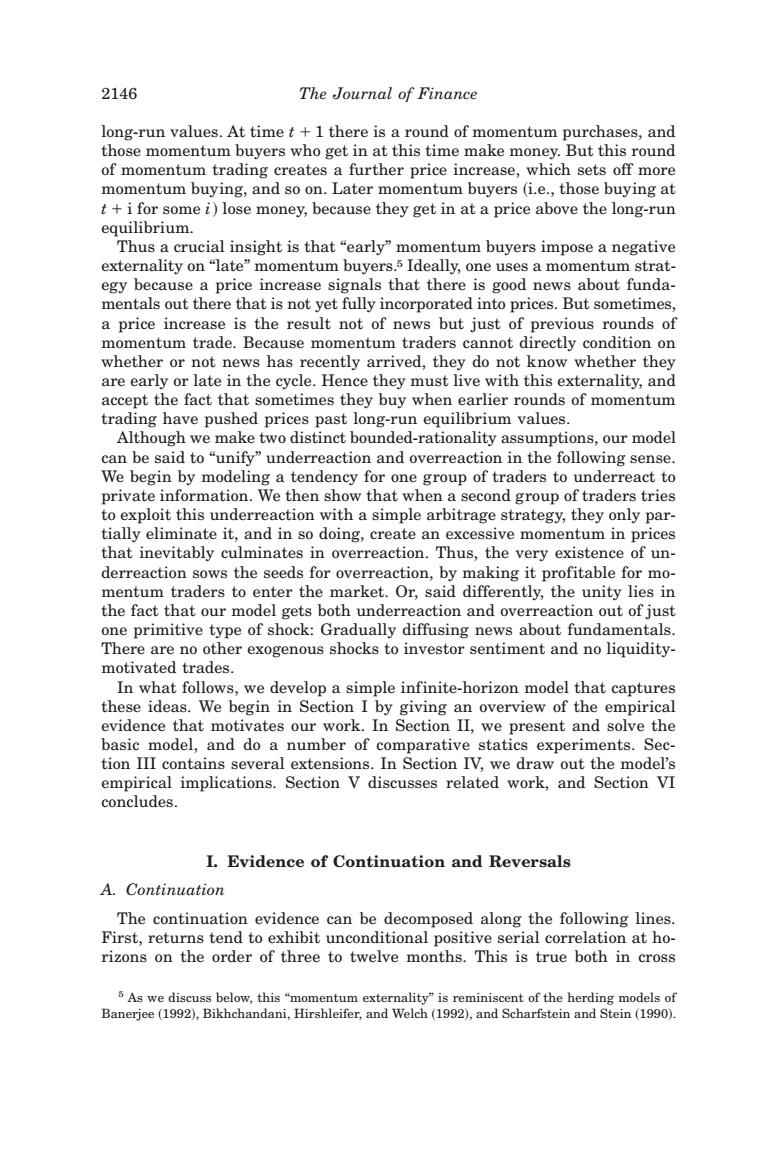正在加载图片...

2146 The Journal of Finance long-run values.At time t+1 there is a round of momentum purchases,and those momentum buyers who get in at this time make money.But this round of momentum trading creates a further price increase,which sets off more momentum buying,and so on.Later momentum buyers(i.e.,those buying at t+i for some i)lose money,because they get in at a price above the long-run equilibrium. Thus a crucial insight is that "early"momentum buyers impose a negative externality on "late"momentum buyers.5 Ideally,one uses a momentum strat- egy because a price increase signals that there is good news about funda- mentals out there that is not yet fully incorporated into prices.But sometimes, a price increase is the result not of news but just of previous rounds of momentum trade.Because momentum traders cannot directly condition on whether or not news has recently arrived,they do not know whether they are early or late in the cycle.Hence they must live with this externality,and accept the fact that sometimes they buy when earlier rounds of momentum trading have pushed prices past long-run equilibrium values. Although we make two distinct bounded-rationality assumptions,our model can be said to "unify"underreaction and overreaction in the following sense. We begin by modeling a tendency for one group of traders to underreact to private information.We then show that when a second group of traders tries to exploit this underreaction with a simple arbitrage strategy,they only par- tially eliminate it,and in so doing,create an excessive momentum in prices that inevitably culminates in overreaction.Thus,the very existence of un- derreaction sows the seeds for overreaction,by making it profitable for mo- mentum traders to enter the market.Or,said differently,the unity lies in the fact that our model gets both underreaction and overreaction out of just one primitive type of shock:Gradually diffusing news about fundamentals. There are no other exogenous shocks to investor sentiment and no liquidity- motivated trades. In what follows,we develop a simple infinite-horizon model that captures these ideas.We begin in Section I by giving an overview of the empirical evidence that motivates our work.In Section II,we present and solve the basic model,and do a number of comparative statics experiments.Sec- tion III contains several extensions.In Section IV,we draw out the model's empirical implications.Section V discusses related work,and Section VI concludes I.Evidence of Continuation and Reversals A.Continuation The continuation evidence can be decomposed along the following lines. First,returns tend to exhibit unconditional positive serial correlation at ho- rizons on the order of three to twelve months.This is true both in cross 5 As we discuss below,this "momentum externality"is reminiscent of the herding models of Banerjee(1992),Bikhchandani,Hirshleifer,and Welch(1992),and Scharfstein and Stein(1990).long-run values. At time t 1 1 there is a round of momentum purchases, and those momentum buyers who get in at this time make money. But this round of momentum trading creates a further price increase, which sets off more momentum buying, and so on. Later momentum buyers ~i.e., those buying at t 1 i for some i! lose money, because they get in at a price above the long-run equilibrium. Thus a crucial insight is that “early” momentum buyers impose a negative externality on “late” momentum buyers.5 Ideally, one uses a momentum strategy because a price increase signals that there is good news about fundamentals out there that is not yet fully incorporated into prices. But sometimes, a price increase is the result not of news but just of previous rounds of momentum trade. Because momentum traders cannot directly condition on whether or not news has recently arrived, they do not know whether they are early or late in the cycle. Hence they must live with this externality, and accept the fact that sometimes they buy when earlier rounds of momentum trading have pushed prices past long-run equilibrium values. Although we make two distinct bounded-rationality assumptions, our model can be said to “unify” underreaction and overreaction in the following sense. We begin by modeling a tendency for one group of traders to underreact to private information. We then show that when a second group of traders tries to exploit this underreaction with a simple arbitrage strategy, they only partially eliminate it, and in so doing, create an excessive momentum in prices that inevitably culminates in overreaction. Thus, the very existence of underreaction sows the seeds for overreaction, by making it profitable for momentum traders to enter the market. Or, said differently, the unity lies in the fact that our model gets both underreaction and overreaction out of just one primitive type of shock: Gradually diffusing news about fundamentals. There are no other exogenous shocks to investor sentiment and no liquiditymotivated trades. In what follows, we develop a simple infinite-horizon model that captures these ideas. We begin in Section I by giving an overview of the empirical evidence that motivates our work. In Section II, we present and solve the basic model, and do a number of comparative statics experiments. Section III contains several extensions. In Section IV, we draw out the model’s empirical implications. Section V discusses related work, and Section VI concludes. I. Evidence of Continuation and Reversals A. Continuation The continuation evidence can be decomposed along the following lines. First, returns tend to exhibit unconditional positive serial correlation at horizons on the order of three to twelve months. This is true both in cross 5 As we discuss below, this “momentum externality” is reminiscent of the herding models of Banerjee ~1992!, Bikhchandani, Hirshleifer, and Welch ~1992!, and Scharfstein and Stein ~1990!. 2146 The Journal of Finance